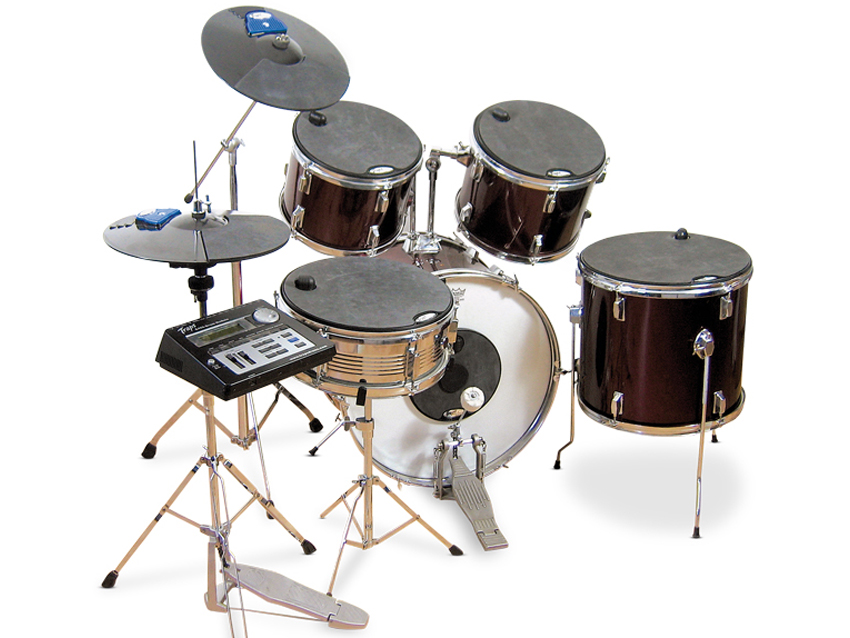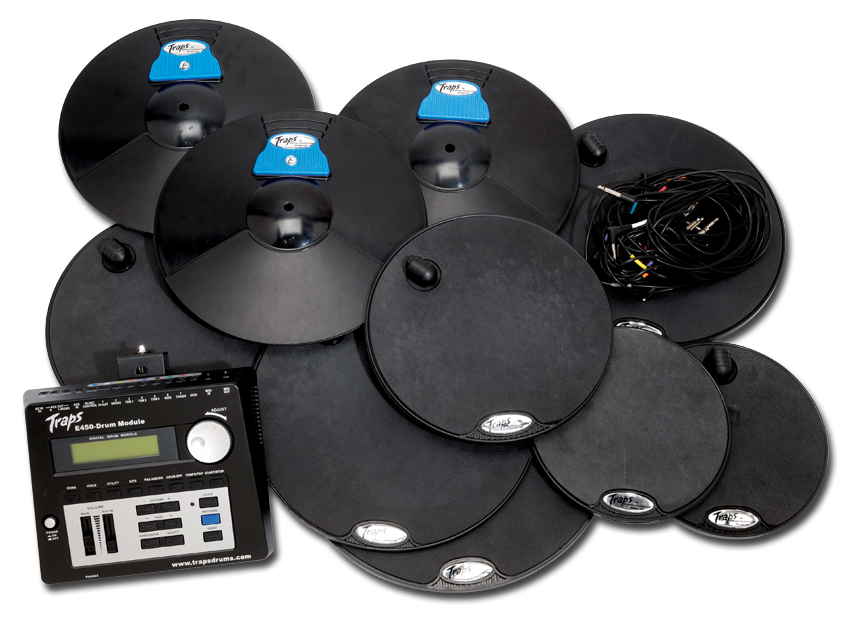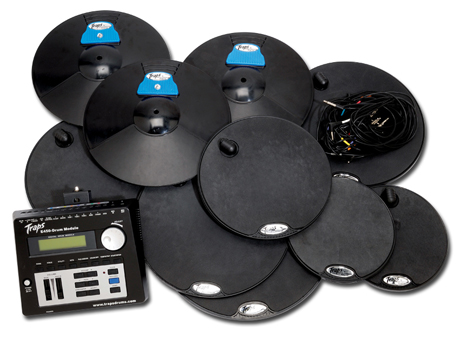MusicRadar Verdict
As a concept, the EPad kit makes so much sense it's a wonder that it hasn't been thought of before. The boon of not having to alter your acoustic kit and yet still being able to practise quietly without having to imagine the drum sounds is enormous.
Pros
- +
Inspired, extremely usable and affordable.
Cons
- -
Some aspects of the brain could be improved.
MusicRadar's got your back

Traps Epad Kit

Traps Epad Kit
Traps is best known for making portable drum kits a serious option for acoustic drummers. Since launching its highly regarded A400 kit the Bournemouth-based company has diversified into the electronic side of the drum market.
The latest Traps product is the EPad kit, an ingenious blend of acoustic practice and triggered electronic kit.
"As a concept, the EPad kit makes so much sense it's a wonder that it hasn't been thought of before"
Build
The EPad kit has been conceived to muffle a regular acoustic kit and at the same time offer the player the option of donning a pair of headphones to utilise the triggers built into each of the pads. Its biggest selling point is its convenience, as no alterations to your acoustic kit are required and, unlike freestanding practice or electronic kits, no extra space is needed either.
EPads are currently sold in two variants, both based around five-piece kits. Fusion packs are based around tom sizes of 10", 12" and 14", while Rock packs cater for 12", 13" and 16" toms. Both packs include a 14" pad for the snare drum and a universal bass drum pad.
Other sizes of pad are available on request on an individual basis and kits can be custom ordered as well.

The kits also come with three moulded ABS cymbals that again contain triggers. Two of the cymbals are designed to be stand-mounted in the usual manner. The third attaches to the clutch on a hi-hat stand while below it sits an ABS collar with a sprung telescopic central section that works in conjunction with the stand's movements.
Depending on whether the pedal is up or down, the brain reproduces an appropriate open or closed hi-hat sound, including stepping and barks.
The drum pads are 12mm thick and are made up of a central disc of moulded ABS sandwiched between layers of sound absorbing foam and sorbothene rubber. Permanently embedded into each pad is a trigger, which is wired to a 1/4" ABS jack socket located close to the edge (ie out of the playing zone) of the pad.
A cable loom is supplied to connect all of the pads to the brain. Each cable is pre-assigned to a specific pad with its destination printed onto a coloured collar at both ends. There are corresponding dots beneath the sockets on the brain that share the same colour coding, so wiring the pads up is difficult to get wrong.
The brain is the Traps 450 drum module that has already seen service with the company's E400 kit. It contains a total of 389 voices, with 20 preset and 10 user-programmable kits, 50 play along songs and four recordable tracks. External music sources (such as an MP3 player) can also be plugged in to play along to and, most impressively, a pair of MIDI sockets means that computer-based tutorials can be accommodated as well.
Hands on
Setting the EPads up was child's play as it was simply a question of laying the pads out on the kit (the kick pad attaches via Velcro strips) and plugging them into the correct sockets. As a set of drum silencers they hit the mark, reducing the sound of the kit to a series of dull taps highly reminiscent of conventional practice pads.
Slipping on a pair of headphones transforms the monochrome sound of the pads into the constituent elements of a kit. The 20 preset kits offer a variety of sounds and set-ups and the 10 spare kits can be programmed to your whim.
A good degree of adjustment is available, with essentials such as pad sensitivity dealt with individually and in great detail. The play along songs won't be to everyone's taste (how could they be?) but are fine for practising along to. All of the songs have a pre-recorded drum track (handy for the trickier moments) that can be mixed out.
Alternatively, a click track can be utilised on its own for more freestyle practice.
We had some issues with pad responses, such as the occasional failure to reproduce the odd hit midstream in a flurry of notes, but nothing that got above the level of irritating. While it's fair to say that the brain and pad combination is unlikely to challenge the performance of a high-end electronic kit, it's not meant to. The EPad kit is a practice tool rather than a gigging kit and should be judged as such.
“I have an original 909 – every time I try to use it I feel like I’m ruining it”: House hero Riva Starr on his studio essentials and his love of analogue synths
“A synthesizer that is both easy to use and fun to play whilst maintaining a decent degree of programming depth and flexibility”: PWM Mantis review
“I feel like that song had everything we needed to come back with”: Bring Me The Horizon’s Lee Malia on Shadow Moses, its riff and the secrets behind its tone, and why it was the right anthem at the right time









